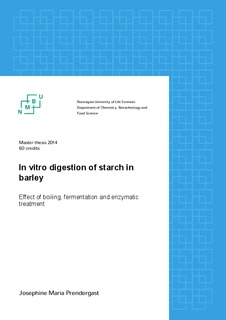| dc.contributor.author | Prendergast, Josephine Maria | |
| dc.date.accessioned | 2014-08-07T11:11:38Z | |
| dc.date.available | 2014-08-07T11:11:38Z | |
| dc.date.copyright | 2014 | |
| dc.date.issued | 2014-08-07 | |
| dc.identifier.uri | http://hdl.handle.net/11250/216878 | |
| dc.description.abstract | Grunnet et høyt innhold av bio-aktive komponenter som fenoliske syrer, blir bygg mer og mer benyttet som en funksjonell matingrediens. Prosessering, som fermentering og koking, kan føre til en frigjøring av disse fenoliske syrene fra byggmatriksen. Dette fordi ulike fysiske og biologiske prosesser foregår i matvaren under prosessering noe som igjen kan påvirke biotilgjengeligheten av fenoliske komponenter.
I denne studien undersøkes effektene av fermentering og koking på frie fenoliske syrer i byggproduktene avskallet bygg, byggflak og byggmel. Fermentering av byggmel med Lactobacillus reuteri SD2112 and Lactobacillus acidophilus LA-5 førte til en signifikant økning i nivå av fri kaffesyre (CA), p- kumarinsyre (p-CA) og ferulsyre (FA) i tillegg til nivå av summen av frie fenoliske syrer. Tilsetning av pentopan førte til en signifikant økning i disse resultatene. Når det gjelder koking ble det kun observert en signifikant økning i summen av frie fenoliske syrer i kokt avskallet bygg. Etter tilsetning av pentopan ble det en signifikant økning i summen av frie fenoliske syrer i byggmel.
Tidligere in vitro fordøyelse-studier har vist at fenoliske syrer kan ha en hemmende effekt på enzymatisk aktivitet av pankreatisk α-amylase. Denne hypotesen blir ikke bekreftet i denne studien. Allikevel, resultatene tyder på at melkesyre og eddiksyre i byggprodukter kan virke hemmende på fordøyelse av stivelse. Denne virkningen kan delvis motvirkes av tilsetting av pentopan. I tillegg til fermentaing kan koking ha en hemmende effekt på fordøyelse av stivelse. Dette er tilfelle for avskallet bygg og byggflak, men ikke byggmel.
Studien kan oppsummeres med at prosessering av bygg har potensial til å øke nivået av fenoliske syrer i tillegg å redusere fordøyelse av stivelse. For øvrig er det ikke alltid en sammenheng mellom disse virkningene.
Bioactive compounds such as phenolic acids have resulted in the widespread acceptance of barley as a functional food ingredient. Food processing methods such as fermentation and boiling can result in a release of phenolic acids from the barley matrix. This is due to the fact that various physical and biological processes are initiated in the barley during processing which subsequently affects the bioavailability of phenolic compounds.
In the present study the effects of fermentation and boiling on the free phenolic acid content in hulled barley, barley flakes and barley flour was investigated. Fermentation of barley flour with Lactobacillus reuteri SD2112 and Lactobacillus acidophilus LA-5 resulted in a significant increase in the levels of free caffeic acid (CA), p-Coumaric acid (p-CA), and ferulic acid (FA in addition to the level of total free phenolic acids. These effects were significantly enhanced by the addition of the commercial xylanase (pentopan). With respect to boiling, a significant increase in the level of total free phenolic acids was only observed in boiled hulled barley. However there was a significant increase in the level of total free phenolic acids in boiled barley flour following the addition of pentopan.
Previous in vitro digestion studies have shown that phenolic acids can have an inhibitory effect on the enzymatic activity of pancreatic α-amylase. This hypothesis is not supported by the current study. However, the results suggest that the presence of lactic acid or acetic acid in barley products may exert an inhibitory effect on the digestion of starch. This effect appears to be partially counteracted by the addition of pentopan. In addition to fermentation starch digestion also appears to be hindered in by thermal processing such as boiling. This is the case for both hulled barley and barley flakes.
A synopsis of the study shows that processing of barley has the potential to increase the level of phenolic acids in addition to decreasing starch digestion. However there is not always a correlation between these effects. | nb_NO |
| dc.language.iso | eng | nb_NO |
| dc.publisher | Norwegian University of Life Sciences, Ås | |
| dc.subject | In vitro | nb_NO |
| dc.subject | Starch | nb_NO |
| dc.subject | Barley | nb_NO |
| dc.subject | Fermentation | nb_NO |
| dc.subject | Boiling | nb_NO |
| dc.subject | Enzymatic treatment | nb_NO |
| dc.subject | VDP::Matematikk og Naturvitenskap: 400::Kjemi: 440::Organisk kjemi: 441 | nb_NO |
| dc.subject | VDP::Teknologi: 500::Næringsmiddelteknologi: 600 | nb_NO |
| dc.title | In vitro digestion of starch in barley : effects of boiling, fermentation and enzymatic treatment | nb_NO |
| dc.type | Master thesis | nb_NO |
| dc.source.pagenumber | 108 | nb_NO |
| dc.description.localcode | M-MAT | nb_NO |
